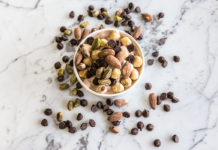
High-Intensity Training (HIIT) workouts are characterized by doing your chosen form of cardio at maximum effort, elevating your heart rate for a short time, followed by resting for a given period.
These kinds of exercises can be done in a 1:1 ratio (such as sprinting for 30 seconds, then resting for 30 seconds), a 1:2 ratio (sprinting for 30 seconds, then resting for 60 seconds), or any other ratio that suits you. The latest research on the ideal intervals of work is 20 seconds for men and 30 seconds for women. Current advice is also to rest after the interval for as long as you need to before going back to work out at maximum effort for the next interval.

There are 2 main energy mechanisms in the body when it comes to exercise: Aerobic (where we are utilizing oxygen) and anaerobic (where the body is using carbs for energy). HIIT training falls into the latter category and is designed so muscles are allowed to recover before the next energy boost. With HIIT, your body has such a high demand for energy that it doesn’t have time to create energy from the oxygen you breathe.
Tabatha, a kind of HIIT training, has a 2:1 ratio, meaning 20 seconds of training and 10 seconds of rest, repeated 8 times for a total of 4 minutes. The sets can be repeated, but 4 minutes of Tabatha training has been found to give you results similar to a 30- to 60-minute moderate cardio routine. It was created by Izumi Tabatha in Japan in the 1990s to improve athletes’ performance and is still used by many people today as part of their weekly workout routine.
Kinds of Exercise to Use for HIIT Training
It is important to work out at maximum effort, so sprinting, star jumps, high knees, plyometrics, any exercise that involves jumping, and any other kind of bodyweight moves are recommended.
You can also do stair work, cycling, rowing, jump roping, and weightlifting.
Benefits of HIIT Training
There are a number of reasons why you should consider HIIT training, including:
- It saves a lot of time.
- You burn more fat and calories than steady-state cardio and this continues for 24 hours post-workout.
- You won’t lose muscle tissue and your human growth hormone (HGH) will increase by up to 450% during the 24 hours after the workout.
- No special equipment is needed.
- You can do it anywhere (even in tiny studio apartments).
- You will build a healthier heart.

How Often to Do HIIT Training
Ideally, you should do HIIT workouts 1 to 2 times a week, allowing at least 48 to 72 hours rest between each session.
If you do too much, your levels of a stress hormone called cortisol will rise, leading to fatigue, joint pain, and mood disturbances.
Most People are Doing Their HIIT Workouts Wrong
According to Thomas De Lauer, a fitness and nutrition expert who bases his information on the latest scientific research, HIIT workouts are 100% ineffective if they are not done the right way.
For example, some people are doing equal intervals of 60 seconds of hard training followed by 60 seconds of rest. But De Lauer says people should never try to work out at full intensity for that long. No one can train effectively at this rate for more than 20 to 30 seconds. Then, the rest period should be as long as you need so you are fully recovered to go all out again, even if it takes a few minutes.
Other Elements of a Great HIIT Workout
One good way to get a strong HIIT workout is to include some jumps or plyometric exercises. During this “jump training,” you will exert maximum force on the muscles in a short space of time, leading to more muscle fiber recruitment. Examples of plyometrics are squat jumps, lateral or long jumps, and jumping jacks.
A research study published in the Journal of Applied Physiology, Nutrition, and Metabolism compared groups of people who had plyometric exercises in their HIIT workouts and those that didn’t. This study found that the group that had them had 3% more improvement in muscle mass, more improvement in power and strength, and better fat-burning results than the other group.
Another good way to beef up your HIIT workout is to include some upper body exercises, like pushups and mountain climbers. A recent study found that HIIT workouts with upper body exercises included more sympathetic nervous system responses and better fat burning. Because the heart has to work harder to pump blood to the upper body, where there are smaller capillaries, the heart rate increases more rapidly.
Conclusion
HIIT training is an essential part of your weekly workout routine. The benefits, like burning calories, losing weight, and improving oxygen levels and blood flow, are great. But be sure to do it the right way so you can maximize these benefits.











